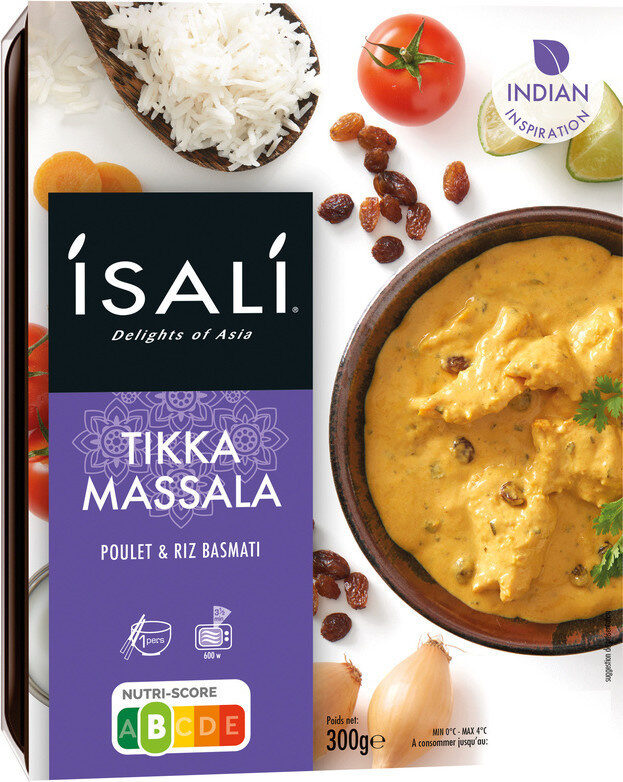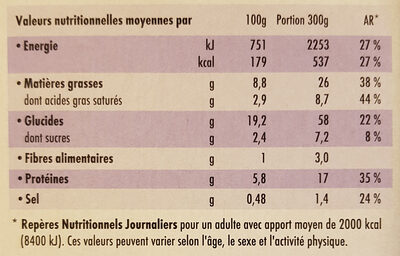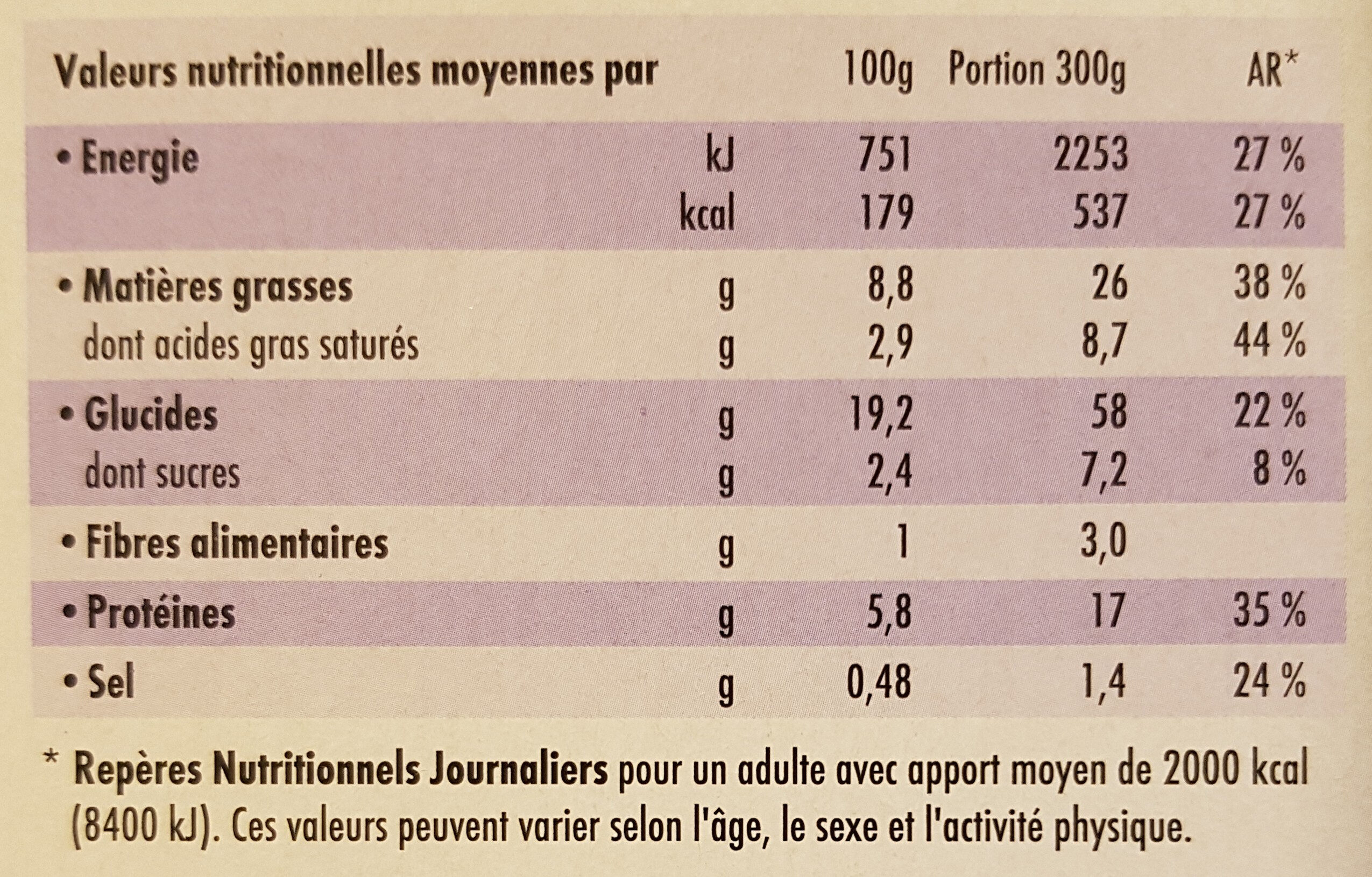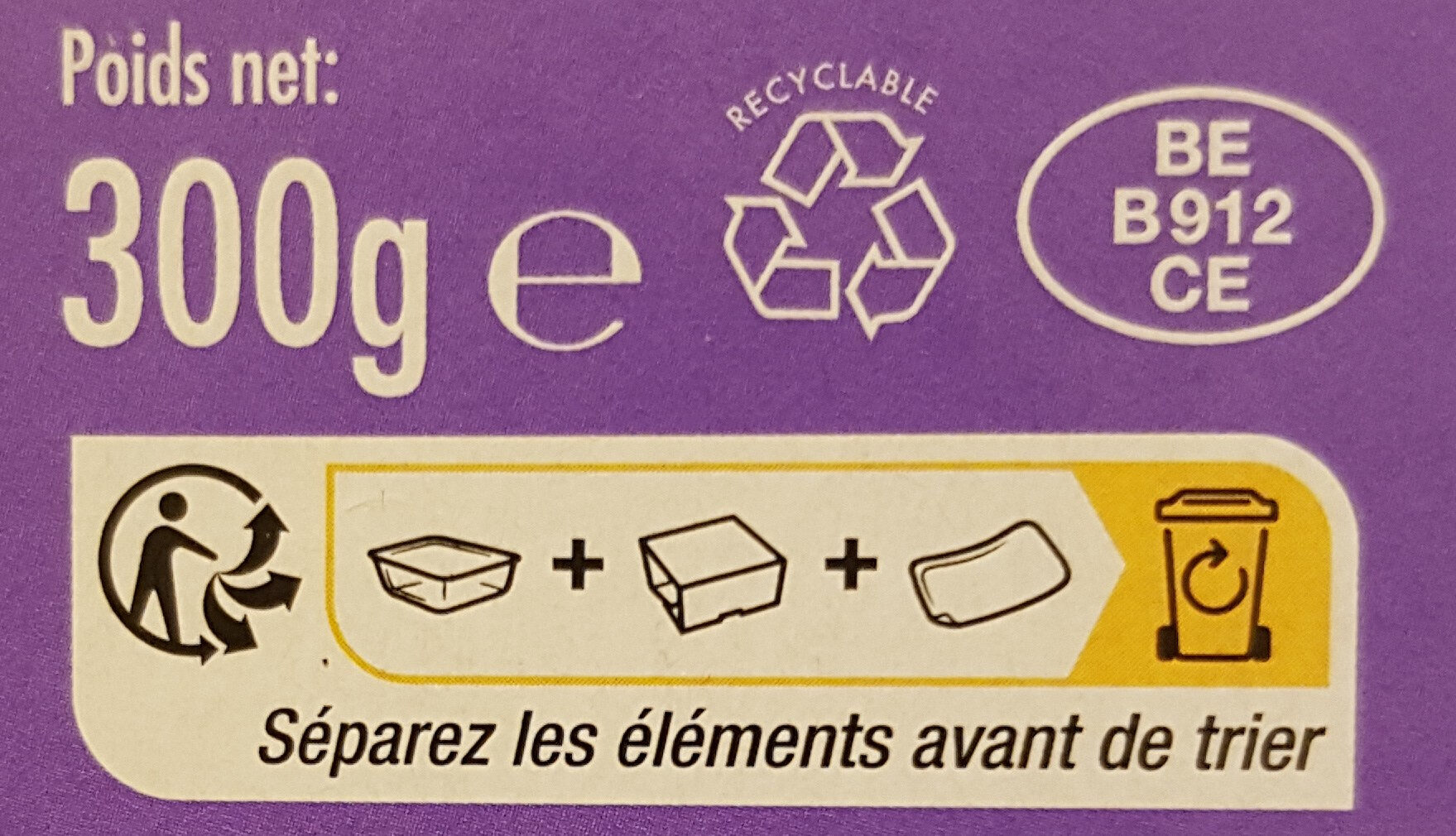Help us make food transparency the norm!
As a non-profit organization, we depend on your donations to continue informing consumers around the world about what they eat.
The food revolution starts with you!
Poulet Tikka Massala - Ísalí - 300 g e
Poulet Tikka Massala - Ísalí - 300 g e
Barcode: 5413110011470 (EAN / EAN-13)
Common name: Recette indienne à base de poulet mariné dans des épices et du yaourt, accompagné de riz Basmati
Quantity: 300 g e
Packaging: Plastic, Cardboard, Fresh, Protective gas
Brands: Ísalí
Categories: Meats and their products, Meals, Meals with meat, Rice dishes, Poultry meals, Meals with chicken, Microwave meals, Chicken tikka masala
Labels, certifications, awards:
2016 Nutrition labelling experiment, FSC, Green Dot, Nutriscore, Nutriscore experiment, Nutriscore Grade B, Triman, fr:Experimentation-nutriscore-0


Origin of ingredients: fr:Lait origine UE, fr:Poulet origine UE
Manufacturing or processing places: Belgique
Traceability code: FSC-C104258, BE B912 EC
Stores: Hyper U, Franprix, Casino, Magasins U, Carrefour, carrefour.fr
Countries where sold: France
Matching with your preferences
Health
Ingredients
-
34 ingredients
: Viande et sauce 60%: poulet 40% (origine: UE), crème, oignons, purée de tomates (tomates, jus de tomates), huile de soja entièrement raffinée, yaourt, carottes, lait (origine UE), œufs, aromates, raisins, sucre, amandes, fécule de pomme de terre, épices, jus de citron, sel de cuisine, stabilisants : gomme xanthane et gomme guar, colorants naturels : rouge de betterave et béta-carotène, huile de tournesol. Accompagnement 40%: riz Basmati (eau, riz Basmati), huile de soja entièrement raffinée, sel de cuisine.Allergens: Eggs, Milk, Nuts, SoybeansTraces: Celery, Crustaceans, Eggs, Fish, Gluten, Milk, Molluscs, Mustard, Nuts, Peanuts, Sesame seeds, Soybeans
Food processing
-
Ultra processed foods
Elements that indicate the product is in the 4 - Ultra processed food and drink products group:
- Additive: E160a - Carotene
- Additive: E162 - Beetroot red
- Additive: E412 - Guar gum
- Additive: E415 - Xanthan gum
- Ingredient: Colour
Food products are classified into 4 groups according to their degree of processing:
- Unprocessed or minimally processed foods
- Processed culinary ingredients
- Processed foods
- Ultra processed foods
The determination of the group is based on the category of the product and on the ingredients it contains.
Additives
-
E160a - Carotene
Carotene: The term carotene -also carotin, from the Latin carota, "carrot"- is used for many related unsaturated hydrocarbon substances having the formula C40Hx, which are synthesized by plants but in general cannot be made by animals -with the exception of some aphids and spider mites which acquired the synthesizing genes from fungi-. Carotenes are photosynthetic pigments important for photosynthesis. Carotenes contain no oxygen atoms. They absorb ultraviolet, violet, and blue light and scatter orange or red light, and -in low concentrations- yellow light. Carotenes are responsible for the orange colour of the carrot, for which this class of chemicals is named, and for the colours of many other fruits, vegetables and fungi -for example, sweet potatoes, chanterelle and orange cantaloupe melon-. Carotenes are also responsible for the orange -but not all of the yellow- colours in dry foliage. They also -in lower concentrations- impart the yellow coloration to milk-fat and butter. Omnivorous animal species which are relatively poor converters of coloured dietary carotenoids to colourless retinoids have yellowed-coloured body fat, as a result of the carotenoid retention from the vegetable portion of their diet. The typical yellow-coloured fat of humans and chickens is a result of fat storage of carotenes from their diets. Carotenes contribute to photosynthesis by transmitting the light energy they absorb to chlorophyll. They also protect plant tissues by helping to absorb the energy from singlet oxygen, an excited form of the oxygen molecule O2 which is formed during photosynthesis. β-Carotene is composed of two retinyl groups, and is broken down in the mucosa of the human small intestine by β-carotene 15‚15'-monooxygenase to retinal, a form of vitamin A. β-Carotene can be stored in the liver and body fat and converted to retinal as needed, thus making it a form of vitamin A for humans and some other mammals. The carotenes α-carotene and γ-carotene, due to their single retinyl group -β-ionone ring-, also have some vitamin A activity -though less than β-carotene-, as does the xanthophyll carotenoid β-cryptoxanthin. All other carotenoids, including lycopene, have no beta-ring and thus no vitamin A activity -although they may have antioxidant activity and thus biological activity in other ways-. Animal species differ greatly in their ability to convert retinyl -beta-ionone- containing carotenoids to retinals. Carnivores in general are poor converters of dietary ionone-containing carotenoids. Pure carnivores such as ferrets lack β-carotene 15‚15'-monooxygenase and cannot convert any carotenoids to retinals at all -resulting in carotenes not being a form of vitamin A for this species-; while cats can convert a trace of β-carotene to retinol, although the amount is totally insufficient for meeting their daily retinol needs.Source: Wikipedia
-
E160ai - Beta-carotene
Beta-Carotene: β-Carotene is an organic, strongly colored red-orange pigment abundant in plants and fruits. It is a member of the carotenes, which are terpenoids -isoprenoids-, synthesized biochemically from eight isoprene units and thus having 40 carbons. Among the carotenes, β-carotene is distinguished by having beta-rings at both ends of the molecule. β-Carotene is biosynthesized from geranylgeranyl pyrophosphate.β-Carotene is the most common form of carotene in plants. When used as a food coloring, it has the E number E160a. The structure was deduced by Karrer et al. in 1930. In nature, β-carotene is a precursor -inactive form- to vitamin A via the action of beta-carotene 15‚15'-monooxygenase.Isolation of β-carotene from fruits abundant in carotenoids is commonly done using column chromatography. It can also be extracted from the beta-carotene rich algae, Dunaliella salina. The separation of β-carotene from the mixture of other carotenoids is based on the polarity of a compound. β-Carotene is a non-polar compound, so it is separated with a non-polar solvent such as hexane. Being highly conjugated, it is deeply colored, and as a hydrocarbon lacking functional groups, it is very lipophilic.Source: Wikipedia
-
E162 - Beetroot red
Betanin: Betanin, or Beetroot Red, is a red glycosidic food dye obtained from beets; its aglycone, obtained by hydrolyzing away the glucose molecule, is betanidin. As a food additive, its E number is E162. The color of betanin depends on pH; between four and five it is bright bluish-red, becoming blue-violet as the pH increases. Once the pH reaches alkaline levels betanin degrades by hydrolysis, resulting in a yellow-brown color. Betanin is a betalain pigment, together with isobetanin, probetanin, and neobetanin. Other pigments contained in beet are indicaxanthin and vulgaxanthins.Source: Wikipedia
-
E412 - Guar gum
Guar gum (E412) is a natural food additive derived from guar beans.
This white, odorless powder is valued for its remarkable thickening and stabilizing properties, making it a common ingredient in various food products, including sauces, dressings, and ice creams.
When used in moderation, guar gum is considered safe for consumption, with no known adverse health effects.
-
E415 - Xanthan gum
Xanthan gum (E415) is a natural polysaccharide derived from fermented sugars, often used in the food industry as a thickening and stabilizing agent.
This versatile food additive enhances texture and prevents ingredient separation in a wide range of products, including salad dressings, sauces, and gluten-free baked goods.
It is considered safe for consumption even at high intake amounts.
Ingredients analysis
-
May contain palm oil
Ingredients that may contain palm oil: E160ai
-
Non-vegan
Non-vegan ingredients: Meat, Chicken, Cream, Yogurt, Milk, EggSome ingredients could not be recognized.
We need your help!
You can help us recognize more ingredients and better analyze the list of ingredients for this product and others:
- Edit this product page to correct spelling mistakes in the ingredients list, and/or to remove ingredients in other languages and sentences that are not related to the ingredients.
- Add new entries, synonyms or translations to our multilingual lists of ingredients, ingredient processing methods, and labels.
If you would like to help, join the #ingredients channel on our Slack discussion space and/or learn about ingredients analysis on our wiki. Thank you!
-
Non-vegetarian
Non-vegetarian ingredients: Meat, ChickenSome ingredients could not be recognized.
We need your help!
You can help us recognize more ingredients and better analyze the list of ingredients for this product and others:
- Edit this product page to correct spelling mistakes in the ingredients list, and/or to remove ingredients in other languages and sentences that are not related to the ingredients.
- Add new entries, synonyms or translations to our multilingual lists of ingredients, ingredient processing methods, and labels.
If you would like to help, join the #ingredients channel on our Slack discussion space and/or learn about ingredients analysis on our wiki. Thank you!
-
Details of the analysis of the ingredients
We need your help!
Some ingredients could not be recognized.
We need your help!
You can help us recognize more ingredients and better analyze the list of ingredients for this product and others:
- Edit this product page to correct spelling mistakes in the ingredients list, and/or to remove ingredients in other languages and sentences that are not related to the ingredients.
- Add new entries, synonyms or translations to our multilingual lists of ingredients, ingredient processing methods, and labels.
If you would like to help, join the #ingredients channel on our Slack discussion space and/or learn about ingredients analysis on our wiki. Thank you!
: Viande, sauce 60% (poulet 40%), UE, _crème_, oignons, purée de tomates (tomates, jus de tomates), huile de soja entièrement raffinée, _yaourt_, carottes, _lait_, _œufs_, aromates, raisins, sucre, _amandes_, fécule de pomme de terre, épices, jus de citron, sel de cuisine, stabilisants (gomme xanthane et gomme guar), colorants naturels (rouge de betterave, béta-carotène), huile de tournesol, Accompagnement 40% (riz Basmati, eau), riz Basmati, huile de soja entièrement raffinée, sel de cuisine- Viande -> en:meat - vegan: no - vegetarian: no
- sauce -> en:sauce - vegan: maybe - vegetarian: maybe - percent: 60
- poulet -> en:chicken - vegan: no - vegetarian: no - percent: 40
- UE -> fr:ue
- _crème_ -> en:cream - vegan: no - vegetarian: yes - ciqual_food_code: 19402
- oignons -> en:onion - vegan: yes - vegetarian: yes - ciqual_food_code: 20034
- purée de tomates -> en:tomato-puree - vegan: yes - vegetarian: yes - ciqual_food_code: 20170
- tomates -> en:tomato - vegan: yes - vegetarian: yes - ciqual_food_code: 20047
- jus de tomates -> en:tomato-juice - vegan: yes - vegetarian: yes - ciqual_food_code: 20047
- huile de soja entièrement raffinée -> fr:huile-de-soja-entierement-raffinee - vegan: yes - vegetarian: yes - from_palm_oil: no - ciqual_food_code: 17420
- _yaourt_ -> en:yogurt - vegan: no - vegetarian: yes - ciqual_proxy_food_code: 19593
- carottes -> en:carrot - vegan: yes - vegetarian: yes - ciqual_food_code: 20009
- _lait_ -> en:milk - vegan: no - vegetarian: yes - ciqual_proxy_food_code: 19051
- _œufs_ -> en:egg - vegan: no - vegetarian: yes - ciqual_food_code: 22000
- aromates -> en:spice - vegan: yes - vegetarian: yes
- raisins -> en:grape - vegan: yes - vegetarian: yes - ciqual_food_code: 13112
- sucre -> en:sugar - vegan: yes - vegetarian: yes - ciqual_proxy_food_code: 31016
- _amandes_ -> en:almond - vegan: yes - vegetarian: yes - ciqual_food_code: 15041
- fécule de pomme de terre -> en:potato-starch - vegan: yes - vegetarian: yes - ciqual_proxy_food_code: 9510
- épices -> en:spice - vegan: yes - vegetarian: yes
- jus de citron -> en:lemon-juice - vegan: yes - vegetarian: yes - ciqual_food_code: 2028
- sel de cuisine -> en:salt - vegan: yes - vegetarian: yes - ciqual_food_code: 11058
- stabilisants -> en:stabiliser
- gomme xanthane et gomme guar -> en:xanthan-gum-and-guar-gum - vegan: yes - vegetarian: yes
- colorants naturels -> en:natural-colours
- rouge de betterave -> en:e162 - vegan: yes - vegetarian: yes
- béta-carotène -> en:e160ai - vegan: maybe - vegetarian: maybe - from_palm_oil: maybe
- huile de tournesol -> en:sunflower-oil - vegan: yes - vegetarian: yes - from_palm_oil: no - ciqual_food_code: 17440
- Accompagnement -> fr:accompagnement - percent: 40
- riz Basmati -> en:basmati-rice - vegan: yes - vegetarian: yes - ciqual_food_code: 9119
- eau -> en:water - vegan: yes - vegetarian: yes - ciqual_food_code: 18066
- riz Basmati -> en:basmati-rice - vegan: yes - vegetarian: yes - ciqual_food_code: 9119
- huile de soja entièrement raffinée -> fr:huile-de-soja-entierement-raffinee - vegan: yes - vegetarian: yes - from_palm_oil: no - ciqual_food_code: 17420
- sel de cuisine -> en:salt - vegan: yes - vegetarian: yes - ciqual_food_code: 11058
Nutrition
-
Good nutritional quality
⚠ ️Warning: the amount of fruits, vegetables and nuts is not specified on the label, it was estimated from the list of ingredients: 0This product is not considered a beverage for the calculation of the Nutri-Score.
Positive points: 4
- Proteins: 3 / 5 (value: 5.8, rounded value: 5.8)
- Fiber: 1 / 5 (value: 1, rounded value: 1)
- Fruits, vegetables, nuts, and colza/walnut/olive oils: 0 / 5 (value: 0, rounded value: 0)
Negative points: 6
- Energy: 2 / 10 (value: 751, rounded value: 751)
- Sugars: 0 / 10 (value: 2.4, rounded value: 2.4)
- Saturated fat: 2 / 10 (value: 2.9, rounded value: 2.9)
- Sodium: 2 / 10 (value: 192, rounded value: 192)
The points for proteins are counted because the negative points are less than 11.
Nutritional score: (6 - 4)
Nutri-Score:
-
Nutrient levels
-
Fat in moderate quantity (8.8%)
What you need to know- A high consumption of fat, especially saturated fats, can raise cholesterol, which increases the risk of heart diseases.
Recommendation: Limit the consumption of fat and saturated fat- Choose products with lower fat and saturated fat content.
-
Saturated fat in moderate quantity (2.9%)
What you need to know- A high consumption of fat, especially saturated fats, can raise cholesterol, which increases the risk of heart diseases.
Recommendation: Limit the consumption of fat and saturated fat- Choose products with lower fat and saturated fat content.
-
Sugars in low quantity (2.4%)
What you need to know- A high consumption of sugar can cause weight gain and tooth decay. It also augments the risk of type 2 diabetes and cardio-vascular diseases.
Recommendation: Limit the consumption of sugar and sugary drinks- Sugary drinks (such as sodas, fruit beverages, and fruit juices and nectars) should be limited as much as possible (no more than 1 glass a day).
- Choose products with lower sugar content and reduce the consumption of products with added sugars.
-
Salt in moderate quantity (0.48%)
What you need to know- A high consumption of salt (or sodium) can cause raised blood pressure, which can increase the risk of heart disease and stroke.
- Many people who have high blood pressure do not know it, as there are often no symptoms.
- Most people consume too much salt (on average 9 to 12 grams per day), around twice the recommended maximum level of intake.
Recommendation: Limit the consumption of salt and salted food- Reduce the quantity of salt used when cooking, and don't salt again at the table.
- Limit the consumption of salty snacks and choose products with lower salt content.
-
-
Nutrition facts
Nutrition facts As sold
for 100 g / 100 mlAs sold
per serving (300g)Compared to: Chicken tikka masala Energy 751 kj
(179 kcal)2,250 kj
(537 kcal)+22% Fat 8.8 g 26.4 g +78% Saturated fat 2.9 g 8.7 g +74% Carbohydrates 19.2 g 57.6 g +28% Sugars 2.4 g 7.2 g -2% Fiber 1 g 3 g -24% Proteins 5.8 g 17.4 g -28% Salt 0.48 g 1.44 g -35% Fruits‚ vegetables‚ nuts and rapeseed‚ walnut and olive oils (estimate from ingredients list analysis) 0 % 0 %
Environment
-
Eco-Score D - High environmental impact
⚠ ️Select a country in order to include the full impact of transportation.The Eco-Score is an experimental score that summarizes the environmental impacts of food products.→ The Eco-Score was initially developped for France and it is being extended to other European countries. The Eco-Score formula is subject to change as it is regularly improved to make it more precise and better suited to each country.Life cycle analysis
-
Average impact of products of the same category: C (Score: 42/100)
Category: Chicken, Basque style
Category: Chicken, Basque style
- PEF environmental score: 0.69 (the lower the score, the lower the impact)
- including impact on climate change: 5.17 kg CO2 eq/kg of product
Stage Impact Agriculture
77.8 %Processing
14.2 %Packaging
2.3 %Transportation
3.4 %Distribution
1.3 %Consumption
0.9 %
Bonuses and maluses
-
Origins of ingredients with a high impact
Malus: -5
Environmental policy: -5
Transportation: 0
Origin of the product and/or its ingredients % of ingredients Impact Unknown 100 %High European Union 0 %High
-
Packaging with a medium impact
Malus: -12
Shape Material Recycling Impact 1 Film Plastic Recycle High 1 Sleeve Cardboard Recycle Low 1 Tray Plastic Recycle High
Eco-Score for this product
-
Impact for this product: D (Score: 25/100)
Product: Poulet Tikka Massala - Ísalí - 300 g e
Life cycle analysis score: 42
Sum of bonuses and maluses: -17
Final score: 25/100
-
Carbon footprint
-
Equal to driving 2.7 km in a petrol car
517 g CO² per 100g of product
The carbon emission figure comes from ADEME's Agribalyse database, for the category: Chicken, Basque style (Source: ADEME Agribalyse Database)
Stage Impact Agriculture
72.0 %Processing
17.7 %Packaging
3.6 %Transportation
5.7 %Distribution
0.7 %Consumption
0.3 %
Packaging
-
Packaging with a medium impact
-
Packaging parts
1 x Film (Plastic: 1.65 g)
1 x Sleeve 300g (Cardboard: 25.3 g)
1 x Tray 300g (Plastic: 20.6 g)
-
Packaging materials
Material % Packaging weight Packaging weight per 100 g of product Paper or cardboard 53.2% 25.3 g 8.4 g Plastic 46.8% 22.25 g 7.4 g Total 100% 47.55 g 15.8 g
-
Transportation
-
Origins of ingredients
Origins of ingredients with a high impact
Origin of the product and/or its ingredients % of ingredients Impact Unknown 100 %High European Union 0 %High
Report a problem
-
Incomplete or incorrect information?
Category, labels, ingredients, allergens, nutritional information, photos etc.
If the information does not match the information on the packaging, please complete or correct it. Open Food Facts is a collaborative database, and every contribution is useful for all.
Data sources
Product added on by adline
Last edit of product page on by hungergames.
Product page also edited by date-limite-app, driveoff, ecoscore-impact-estimator, fgouget, kiliweb, magasins-u, moon-rabbit, openfoodfacts-contributors, packbot, roboto-app, scanparty-franprix-05-2016, spotter, stephane, tacinte, yuka.UTZNU0Zib2V2ZHNWbDhjRjgwUEg4ZDVUbDZLVlZuaTVBTW9YSVE9PQ, yuka.sY2b0xO6T85zoF3NwEKvllEZVP3P_zHHBiDfiXbVxcazd5O3X-ty-qv-Mqs, yuka.sY2b0xO6T85zoF3NwEKvlnYYCYXA_xn2CTzjxxCI7ezfD4P4SOBU-bj4GKo.












